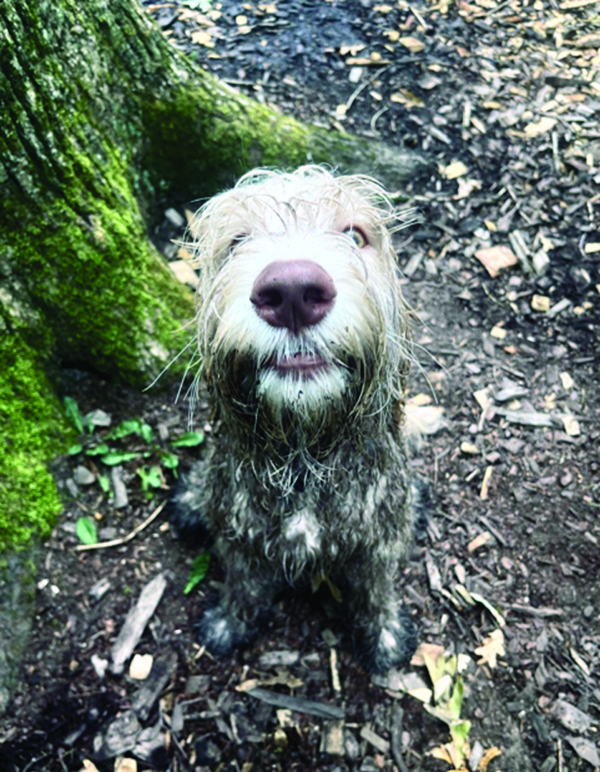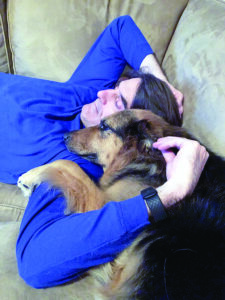
Some of the happiest dog people I know never even meant to get a dog. Their stories run the gamut – from a stray who showed up on a vacation to a pup inherited from the too-spontaneous college kid – but they all have one key thing in common: the lack of expectation.
Often, when I meet these dogs, I notice a little list of behaviors I myself would work on – until the owner busts into a big grin and says, “Isn’t she just great? Can’t believe how this worked out.”
Ha! Awesome. Never mind! I’m here if they ever need me.
In contrast, one of the sadder things I see is the much-anticipated pup – long planned for, much-researched – who is a continual source of frustration. From the level of owner emotion on display before our first training consultation, I expect to encounter a very challenging dog. Instead, I meet a regular dog, who just doesn’t happen to match up with a very precise, idealized picture.
Oh, how I hate the extra burden of expectation these dogs carry. The biggest favor you can do your dog is to lose the vision – and meet the unique spirit in front of you.
THE TRAP OF UNMET EXPECTATIONS
There are different versions of the trap of unmet expectations. One of the most common is what I call the legacy of the ghost dog. This is the previous dog who has passed on, either recently or decades ago. I hear about how these dogs were “perfect” and they never (insert undesired behavior here). The thing is, this assertion usually breaks down under a gentle query or two:
- “Gosh, he was immediately housebroken?” (Well, it turns out they got him as an adult, not a puppy.)
- “Wow, you never had to replace anything chewed?” (Well, it turns out that this owner was 10 years old at the time and likely mom was the one noticing and replacing.)
- “She was never jumpy and always just lay at your feet?” (Well, it turns out that was absolutely true – in years 11 through 16!)
Generally, we savor our sweetest memories of our dear departed dogs and remember them at their very finest hour. That’s mostly a lovely thing, but it’s ever-so damaging to the dogs who come next.
Do yourself and your new pup a favor: Try to avoid comparisons. But if you can’t do that, be sure to take off the rose-colored glasses. They are blocking you from seeing the fresh new possibilities in front of you.
Sometimes it’s not a departed dog but a fictional one that gets in the way. Some folks have richly imagined visions of what their life with a dog will look like, and when the reality doesn’t – and can’t – match up, it becomes a giant problem. Here are some typical ways the real live dog comes up short:
- The non-dog-park dog. That local dog park sometimes looks so fun from the outside that folks end up considering a dog just to be a part of it. They love to think about trotting their happy dog to its favorite place, where, coincidentally, the owner will get to enjoy that easy human socializing. When it turns out their actual dog (like so many dogs) is not cut out for the dog park scene, the sense of dismay – even betrayal! – is overwhelming. “But this is why I got a dog!”
- The non-snuggler. At the root of many a dog acquisition is the vision of never again Netflixing alone. Would-be dog owners picture that couch as a nightly snuggle-fest. How bitter the realization, then, when the new dog clearly demonstrates that she’d rather lay on the nice cool tile floor than the cozy sofa – or, if she does lay on the couch, gets up to move if you try to sit close to her. Talk about adding insult to injury! “But I got a dog to have somebody to snuggle with!”
- The dog who loves the wrong person. Sometimes a household decides that one member “needs” to have a special friend. Maybe one dog already loves the hubby so the wife needs “hers.” Or maybe a son really wants his “own” dog. This vision delights everyone involved, so they pick a dog. But three weeks later, that dog is glued to the wrong person!
STACKING THE DECK
In a perfect world, prospective dog owners would ask trainers for help in finding and choosing a dog who could easily deliver the owner’s most-wanted traits – or at least, rule out candidates who are unlikely to be capable of delivering those traits. That would help stack the deck in favor of the human/dog relationship.
More commonly, though, folks come to training classes or phone consultations with a trainer with a dog already acquired and a small list of grievances already started. If we’re consulted early enough, even about a dog who isn’t a perfect fit, trainers can often help move the needle toward the owner’s vision of a great dog in those first days, weeks, and months. Here’s how we’d do that in the cases of the previously mentioned “disappointments”:
- To help create a dog park dog, we’d be carefully exposing the pup to all sorts of safe-and-fun doggy friends, helping her to have a great time and build her skills. If there’s happy body language telling us the pup is all in at each stage, we’d gradually move from one-on-one play to neighborhood group play, to the dog park when it’s empty, etc. We’d be watching like a hawk to make sure we quit while we were ahead, and keeping our distance from trouble.

- To help create a snuggler, we’d first tire out that pup. (Nobody snuggles when they’re bursting with too much energy.) Then we’d make sure the humans show restraint in their search for the cuddle. With a dog who’s a tentative snuggler, we’d teach the humans to cherish the simple head on the lap without immediately moving in for the whole-body hug-and-massage.
- To guide the dog toward loving the one he’s “assigned” to love, we’d advise the family to make sure that human is the primary giver of all good things at first: food, play, walks.
- You get my drift. There are always some things trainers can do – if we’re consulted!
BE OPEN TO NEW EXPERIENCES
That said, there are no guarantees. We can’t change who a dog essentially is. Sometimes, our real goal in these training sessions is to get owners to delight in the dog in front of them, and to be open to the idea that this dog – this exact dog, without the changes the owners want to impose – may open an unexpected world for them.
If this is you – and you’re feeling let down by the reality of your new dog – here’s my advice: Rather than working really hard (often against nature) to force a new dog into a specific vision, try being open to the experience this real live dog is just waiting there to give you.
If he’s terrified at the dog park, maybe that means the two of you could take amazing hikes instead. Maybe this will give you the chance to find trails in your area you’ve never seen before and spend more time more bonding with your dog.
Yeah, it’s a bummer that she won’t cuddle. But maybe she’ll draw you to the dog park – the last place you ever would have gone – where you’ll run into your future husband. (After all, I did! Seriously. True story!)
LOVE THE ONE YOU HAVE
Sometimes I think about how we dog people usually have a few dogs in our lifetime. But our dogs only have us. They live their whole lives just with us. This is it. It would be a shame to keep wishing they were somebody else and letting that hard-headed outlook block us from discovering who they really could be. And who we could be together.






Great article, thanks! My experience was I wanted a quiet, low-key dog. I picked what I thought was the quietest one and three days at my house and he was bouncing off the walls. Well, I learned how to play fetch tennis with him (this was before Chuck-Its), train a perfect recall, so I could let him off-leash in a safe area (also before dog parks) and take 2 walks/day in any weather.
I loved your article. All of us who been lucky enough to have had multiple dogs can relate. I had Spencer over 16 years, then I got Patrick. I expected Patrick to be fully housetrained, be obedience trained, etc, in essence I expected Patrick to be Spencer. Rough going initially until I realized what a gift Patrick was…in his own way. He was NOT Spencer, but that was okay he won my heart just by being himself.
What a delightful article! I’ve had dogs my whole adult life, always from puppy-hood on and one of the many joys was watching their own little personalities develop…same owner, often same house, different little ‘selfs’. As I am now 71, I recently decided on adopting an older dog. He is a 7 year young-at-heart pure delight canine love bug. Of course he came with his personality already there and I’ve had to adjust some but I wouldn’t have it any other way. Just like all my dogs, I watch his love & trust for me growing and he makes me laugh every day.
I also adopted my “senior puppy”, a black cocker spaniel I named Sammy (Davis, Jr.) when he was already 7! He’s a spry 16 now, my own personal trainer! In my “new math: 16-7 equals 9, right? So in my mind “he’s only 9”. I love him to the core!
When I’ve been searching for a new dog, I try to NOT get one that looks like the previous dog. I’ve had Labs since 1986 and when a beloved black died, I waited some months then decided to get a yellow. The problem – a little black puppy chose me! I mourned my previous dog so hard it took me months to recognize what a treasure I had in front of me! Since her death many years ago, I ended up with ANOTHER black (along with a yellow I’d gotten previously) and had to go through the same methods. Understanding the new little black was her own dog! When she died, at 15, and the yellow at 14, I did get a chocolate male who was the WORST puppy ever (seriously) but has turned into the most fabulous dog at just under 2. He’s a joy and a delight every day.
The sweetness of this article left me in tears. I’m in the last bit of time with a rescue dog who wasn’t much of what I had envisioned, but who blossomed into a joy when given bilateral TPLO for her congenitally agonizing knees and plenty of room to be herself. I haven’t been able to do with her the things I did with my previous dogs, but all too soon she’ll leave me with memories of her own version of a “perfect dog”.
I guess I’ve been very fortunate in that every dog thats come to live with me has sort of just happened. From the 6 month old hound/shepherd pup who chose me rather than his “owners” – 4 consecutive German Shepherds – 2 chocolate labs and now a “lab-mix” from the local humane society. All just wonderful, great dogs who I mourned & missed – the last 3 adopted grown dogs. Again, I would do the same thing I did for Axel (8 years old). Rescue is really the best option of all.
Your article rings so true with me. I’m a retired pet-sitter and a certified dog trainer. I, too, have observed the unmet expectations of some of my clients, and even friends.
People are often amazed and how quickly animals(especially dogs) bond with me. I am convinced it’s because I respect and enjoy them for who they are.
Thank you for this wonderful article. I have a lively house with several dogs. Each one has its own personality and own space to claim for rest and relaxation. We play ball several times a day to exercise and take walks on our two acres. I love these dogs, each for who they are. What you said about humans having several dogs, but they only have us made me cry. This is not the life they chose, but the life we chose for them. Their needs should be respected, and we should be the patient ones.
May I make a suggestion? You are such a good writer, and make your point patiently and with compassion. Could you write an article about the fact that dogs DO NOT speak english, or any human language. We need to be patient and train accordingly. Maybe you have already touched on this at some point?
Until Freyja, I’ve always had puppies so as they grew I learned their personalities, likes and dislikes. Ramses hated the dog park. We tried it a few times but he never left my side, always on hyper alert. Candy, my parent’s dog loved the park and to socialize with all of the dogs and people. I thought she would help Ramses get over his hyper-alert but he never did so we stopped going. He wasn’t the snuggler or the kisser that Caesar was but he had his own special qualities. I’ve always accepted each dog as it came with no expectations.
My parents slipped a bit after Candy passed, calling Dolly Candy and occasionally saying Candy never did that. There were some comparisons but they quickly passed as Dolly grew and her personality came out. She is more of a snuggler than Candy was and they love that.
Freyja I adopted as an adult. The only expectation I had was a DNA test coming back Keeshond. I had a second done to confirm she is a husky mix, not Keeshond. Then I started doing research on huskies to meet her expectations. Still haven’t found her “thing” other than wanting to be near me constantly and kiss me a lot. She didn’t seem to like coursing. I may try scentwork or urban sledding but for now, we all just hand out in the yard together and she seems content with that. She has certainly mellowed since I got her. She has become a lot more calm and contented now that she has internalized she has a forever home and will never go back to a shelter again.
I so appreciated this article, since I know my 14 year old dog won’t be with me forever. He has been a joy, but I realize he is one of a kind and no new dog will be like him, but a new adventure.